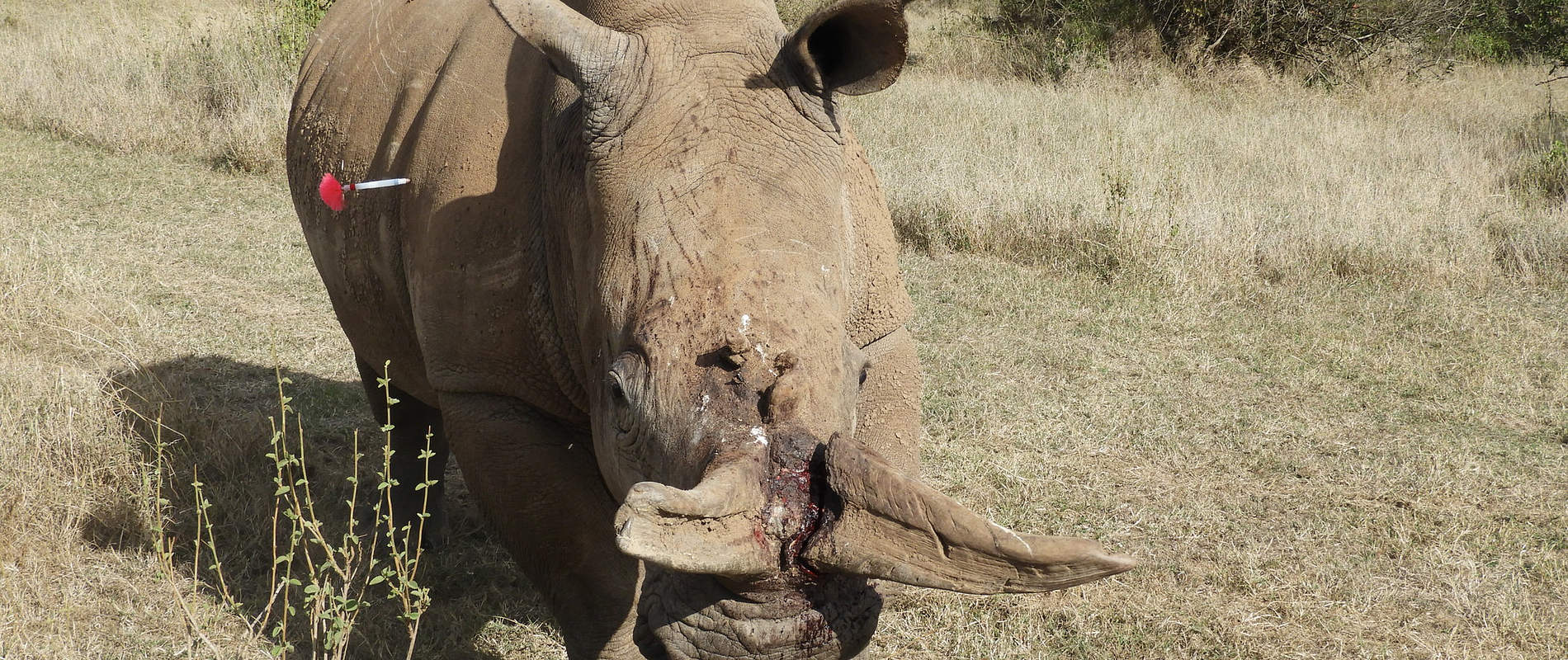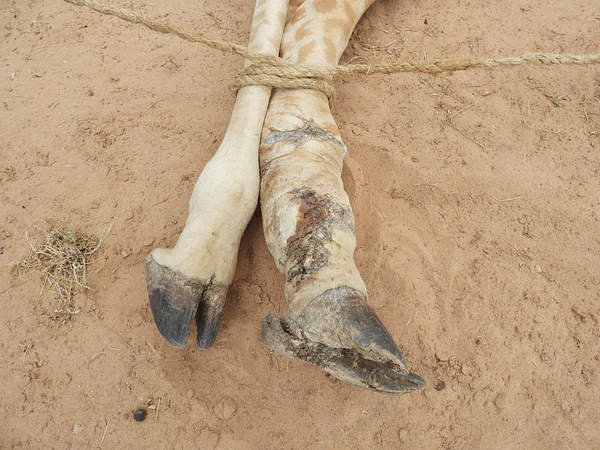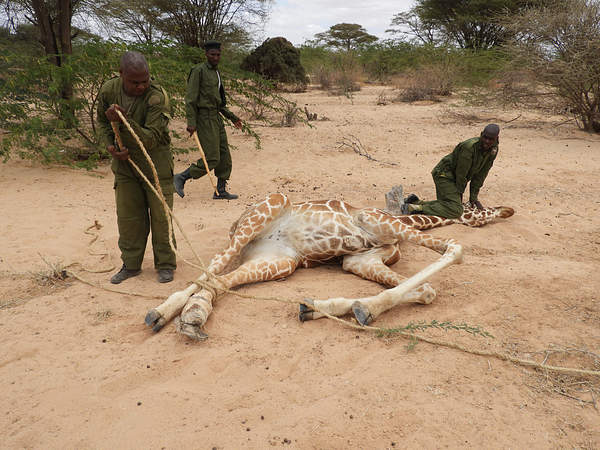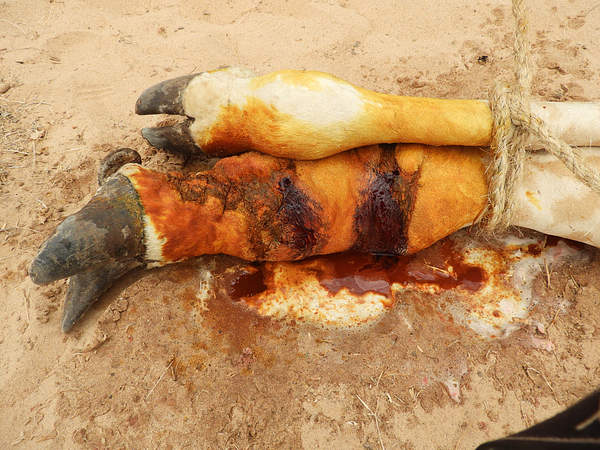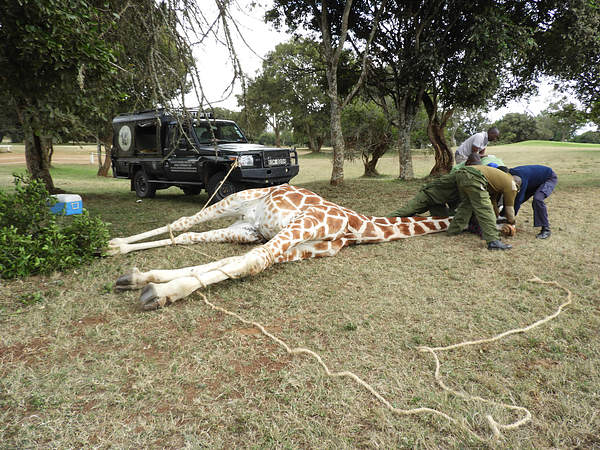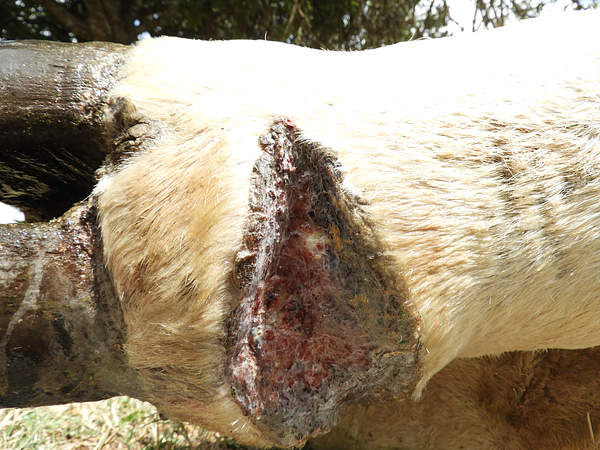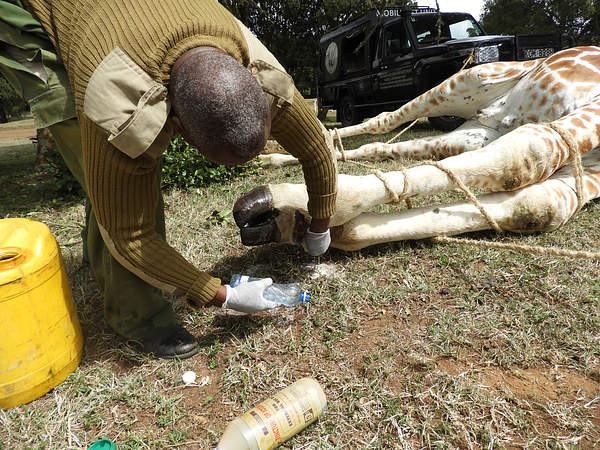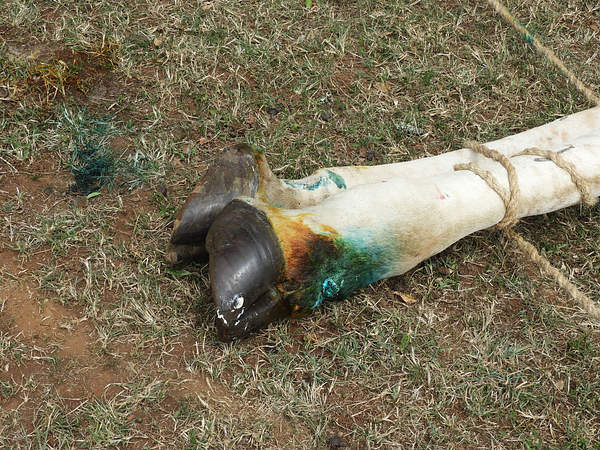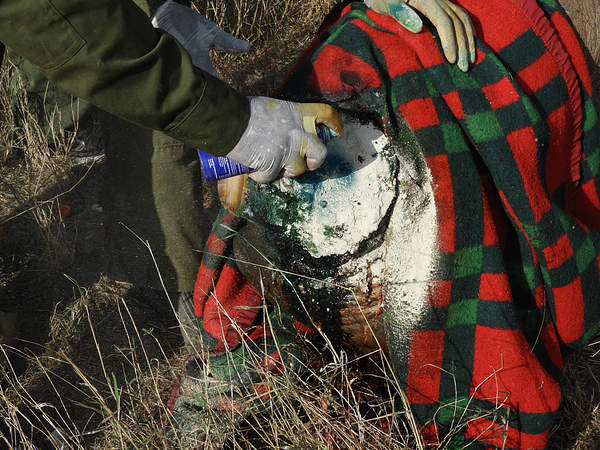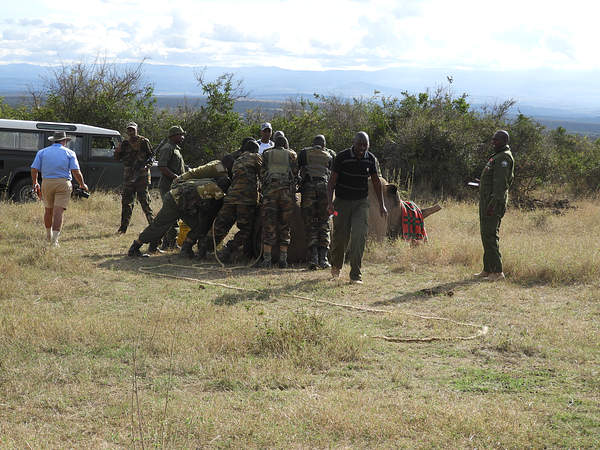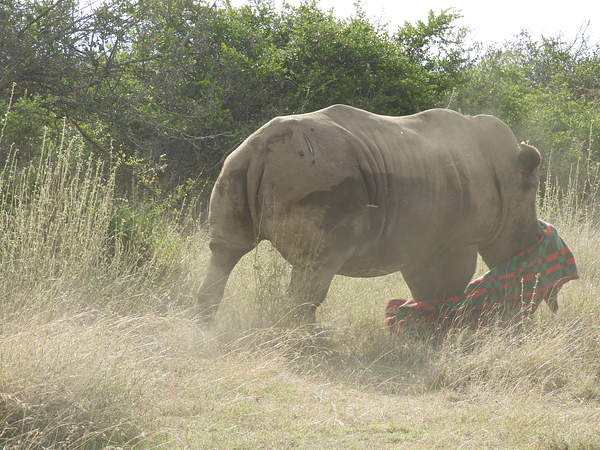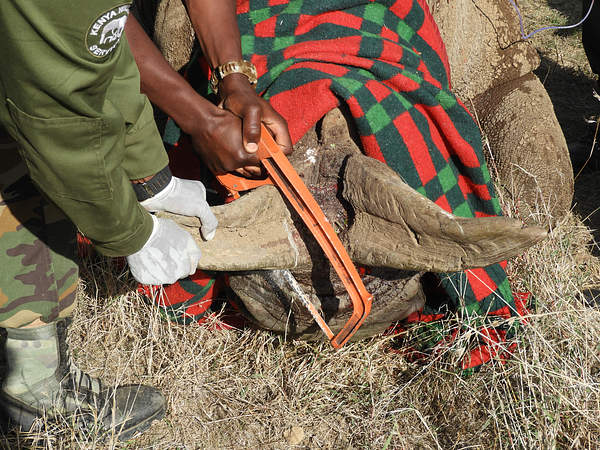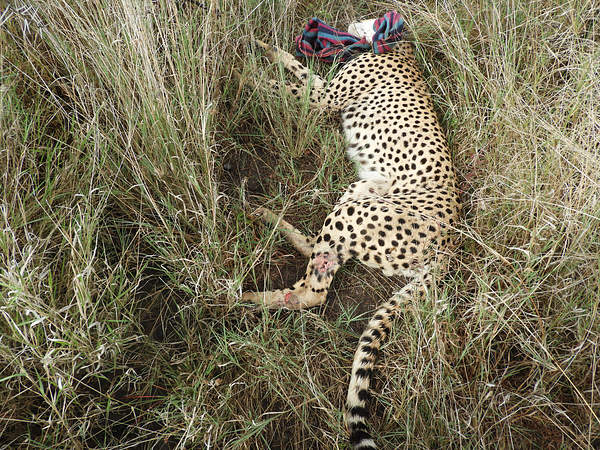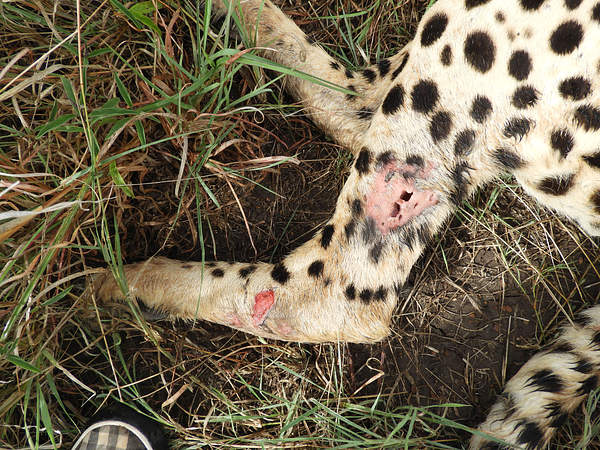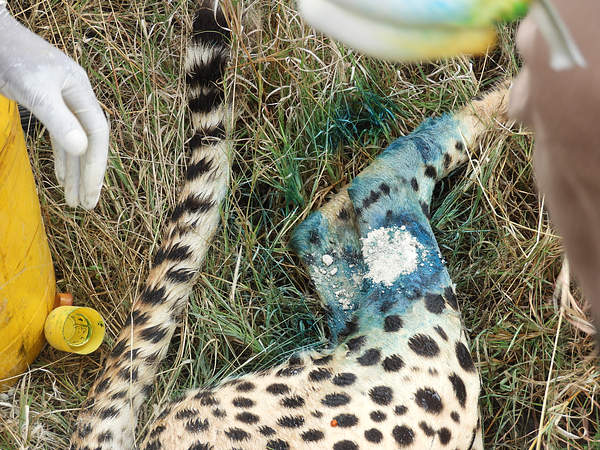The dry season continued through this month, with little rainfall received in parts of northern Kenya during the last week of October, marking the beginning of the short rains. We treated several species of wildlife including three elephant from different conservancies all showing signs of lameness and a white rhino in Solio Ranch which injured its front horn. In Garissa a reticulated giraffe was treated for snare injuries while at the Aberdare Country Club another reticulated giraffe was treated for a chronic wound on its front leg. A cheetah in Segera Ranch was treated for bite wounds and in Ngoteiya Conservancy, Laikipia a young male leopard was attacked by an older male and severely injured on its vertebral column.
CASE#1 LAMENESS IN ELEPHANT
Date: 11 October 2018
Species: Elephant
Sex: Male
Location: Dol Dol
History: This elephant showed severe lameness on its left hind leg over two days. It was immobilised to determine the cause of lameness and treatment.
Immobilization, examination and treatment: Immobilisation was achieved using Etorphine Hydrochloride 12mg delivered in a 1.5cc DanInject dart into the left gluteal muscle. Induction time was 13 minutes. Examination showed a swollen left thigh with excessive mobility of the femur.

Manipulation showed crepitus, indicating a fracture of the femur. The cause of this fracture may be blunt force trauma sustained during a fight. Bone fractures in elephants have a poor prognosis. However, a conservative treatment approach was considered. Antibiotics and anti-inflammatory drugs were administered.

Reversal and prognosis: To reverse anesthesia Diprenophine Hydrochloride was given intravenously and the elephant was assisted to standing position using ropes. Rangers were advised to monitor the young bull and report on his progress.
CASE#2 LAMENESS IN ELEPHANT
Date: 13 October 2018
Species: Elephant
Sex: Male
Location: Borana Conservancy
Management and treatment: This elephant which showed lameness on its front right leg due to suspected fracture was previously treated by the Laikipia Veterinary Unit in Ole Nashu Ranch. The elephant crossed to Borana Conservancy where a review was conducted on the 13th of October and subsequently on the 19th of October.

During this period the elephant showed progressive deterioration of its body condition and manifest pain thus affecting its welfare. The elephant was euthanized on the 19th of October to relieve him from continued suffering from an incurable fracture.
CASE#3 SNARE REMOVAL IN RETICULATED GIRAFFE
Date: 15 October 2018
Species: Reticulated giraffe
Sex: Female
Location: Bouralghy conservancy, Garissa
History: Three giraffe were reported to have shown severe lameness in Bouralghy Conservancy in Garissa County. We examined each of these animals and found that two of them had deformities which did not require further intervention. One giraffe, a young female, had a swollen leg with a septic wound and overgrown hooves which needed further investigation.

Immobilization, examination and treatment: This giraffe was darted from a vehicle. A combination of Etorphine Hydrochloride 8mg and Azaperone Tartate 30mg was used to achieve immobilization. The giraffe was roped to lateral recumbence 7 minutes after darting and restrained physically for examination.
The distal aspect of the left hind leg was swollen at the fetlock with a draining wound caused by a deep snare wire. The snare had strangulated tissues causing hoof deformity. The snare was carefully removed by cutting and pulling from end to end. The septic wounds were washed and debrided, and a topical Iodine based antiseptic was applied. Parenteral antibiotic and anti-inflammatory drugs were also given.

Reversal and prognosis: Anesthesia was reversed immediately the animal was recumbent using Naltrexone Hydrochloride 120 mg administered intravenously through the jugular vein. The giraffe was assisted to standing position using ropes after treatment. We are confident it will recover and regain its full health after this treatment.
Our mobile vet initiative is in the field every day saving wild lives
CASE#4 LAMENESS IN RETICULATED GIRAFFE
Date: 19 October 2018
Species: Reticulated giraffe
Sex: Male
Location: Aberdare Country Club (ACC)
History: This giraffe in Aberdare Country Club (ACC) showed progressive lameness for the past 6 months. It was previously treated in May 2018. The cause of this lameness on the right forelimb was an avulsion wound around the coronary band probably from traumatic injury in the rocky terrain around the club.

Immobilization, examination and treatment: The giraffe was immobilized with Etorphine Hcl 10mg and Azaperone Tartarate 40mg combined in one intramuscular 3ml Dan-inject dart. Six minutes later the giraffe was cast down using ropes and restrained for treatment. The wound was approximately 10CM wide and 4CM deep with loss of connective tissue.
It was washed and debrided to expose the underlying healthy proliferative tissue using diluted Hydrogen Peroxide and disinfected using diluted Tincture of iodine. Green clay was smeared to hasten the healing process and the wound was covered adequately with Oxytetracycline aerosol and fly repellant. The giraffe was administered with Amoxicillin Trihydrate 15000mg and Flunixin Meglumine 1000mg administered intramuscularly.
The cause of this chronic wound could not be immediately determined. No foreign body was found in the wound, however, its location on the medial aspect of the coronary band predisposes to continuous injury thus delayed healing. There is need for further investigation to determine if the phalangeal bones are affected.

Reversal and prognosis: Anesthesia was reversed using Naltrexone Hydrochloride 120 mg administered intravenously through the jugular vein. It was assisted to standing position using ropes. Prognosis for healing is fair to guarded, we therefore advised close monitoring and a review treatment within 14 days if this giraffe is seen.
CASE#5 SPLIT HORN IN A WHITE RHINO
Date: 26 October 2018
Species: White rhino
Sex: Female
Location: Solio Ranch
History: An adult female white rhino with a two year old calf in Solio ranch injured its rostral horn. This horn had a natural split which due to trauma injured the base of the horn. This rhino was immobilized to trim the horn to avoid further injury.

Immobilization, examination and treatment: Immobilization was achieved using a combination of Etorphine and Azaperone delivered in a DanInject dart into the shoulder muscle. Darting was done from a vehicle. An intravenous injection of Butorphanol 20mg was given when the rhino was recumbent to modulate the effect of opioid anesthesia. The rostral horn had split into a left and right section while the caudal horn was rudimentary.
The right section was not firmly attached to the base and had a septic wound with maggot infestation. The left section was trimmed using a saw at approximately 7CM from the base of the horn while the right section was excised from the base of the horn including the germinal layer. The edge of the trimmed horn was smoothened with a file. The wounds were treated with diluted Hydrogen Peroxide and Povidone Iodine. Antibiotic and anti-inflammatory drugs were also administered.
Reversal and prognosis: Anaesthesia was reversed by intravenous injection of Naltrexone Hydrochloride 120mg into the ear vein. Three minutes later the rhino was standing. We are confident that this rhino will make a complete recovery soon.
CASE#6 BITE WOUNDS IN A CHEETAH
Date: 27 October 2018
Species: Cheetah
Sex: Male
Location: Segera Ranch
History: A tour driver on a routine game drive found this cheetah in Segera Ranch which showed lameness on its left hind leg. Closer observation revealed a large wound which needed treatment. On receiving this report the Meru Veterinary team drove to Segera Ranch to treat the cheetah.
Immobilization, examination and treatment: To immobilize this cheetah we used a combination of Ketamine and Medetomidine delivered in a Daninject dart into the gluteal muscles. Three minutes later the cheetah was recumbent. Examination showed deep bite wounds with sepsis on the lateral aspect of the left leg affecting the soft tissue.
Manipulation did not show bone or joint damage. In the inguinal area patchy hair loss with red scaly skin caused by suspected parasitic infestation was observed. The wound was treated locally by shaving the hair, debridement and application of topical antibiotic. Antibiotics and anti-inflammatory drugs were also injected. Ivermectin injection was administered to treat parasitic infection.

Reversal and prognosis: Anaesthesia was reversed one and half hours later by intramuscular injection of Atipamezole. The cheetah was monitored until it was fully recovered from anesthesia. It is expected to recover quickly from its injuries.
CASE#7 LAMENESS IN ELEPHANT
Date: 29 October 2018
Species: Elephant
Sex: Male
Location: Laikipia Nature Conservancy (LNC)
History: A young male elephant which was part of a large herd in the centre dam of Laikipia Nature Conservancy showed a swollen front right leg and severe lameness. Following the report on 29th October 2018 the DSWT dispatched an aircraft with a veterinarian and one capture ranger from the Meru Vet Unit to examine and treat the elephant.
Immobilization, examination and treatment: Darting was done from a helicopter due to the dense vegetation in the area. A dart containing Etorphine hydrochloride 10mg was delivered into the dorsal aspect of the left lumbar muscle. Induction time was 9 minutes.

Examination showed a septic wound on the right elbow joint approximately 3 CM wide by 15CM deep. Probing with forceps showed that the wound did not penetrate into the joint capsule. Probable cause was a spear injury. The wound was debrided with diluted Hydrogen Peroxide to remove pus and Povidone Iodine was used to disinfect the wound. Antibiotics and anti-inflammatory drugs were also administered.
Reversal and Prognosis: After treatment anesthesia was reversed by intravenous injection of Diprenophine Hydrochloride 36mg. Two minutes later the elephant was standing. There is plenty of vegetation and water in this area for this elephant, which is expected to make a complete recovery in the coming days.
CASE#8 INJURED LEOPARD
Date: 29 October 2018
Species: Leopard
Sex: Male
Location: Ngoteiya conservancy
Rangers on patrol at Ngoteiya Conservancy found a recumbent one year old male leopard. They reported that it was unable to move and requested for an examination and treatment of this leopard. The leopard was severely dehydrated and comatose.

Examination showed bite wounds along the vertebral column at the mid thoracic vertebrae. Manipulation revealed fracture of vertebrae with paralysis of the hind legs and abdominal muscles. The bite wounds were inflicted by a male leopard consistent with infanticidal behavior observed in this species. Since the injuries could not be treated the comatose leopard was euthanized by intravenous administration of Pentobarbital Sodium.
CASE#9 PROPHYLACTIC TREATMENT FOR CANINE TRYPANOSOMIASIS
A KWS tracker dog in Meru National Park was given preventive treatment against canine trypanosomiasis which is prevalent in the park. Triquin® 1ml was injected by subcutaneous route and is expected to give 3 months cover against trypanosomiasis.
Acknowledgement
Report by KWS Vet Dr Rono. The Meru Veterinary unit is supported by the David Sheldrick Wildlife Trust to provide wildlife veterinary services in northern Kenya. We would like to acknowledge the support of rangers in various conservancies who monitor and report injured wildlife for treatment and KWS management for providing logistical support to the unit.
